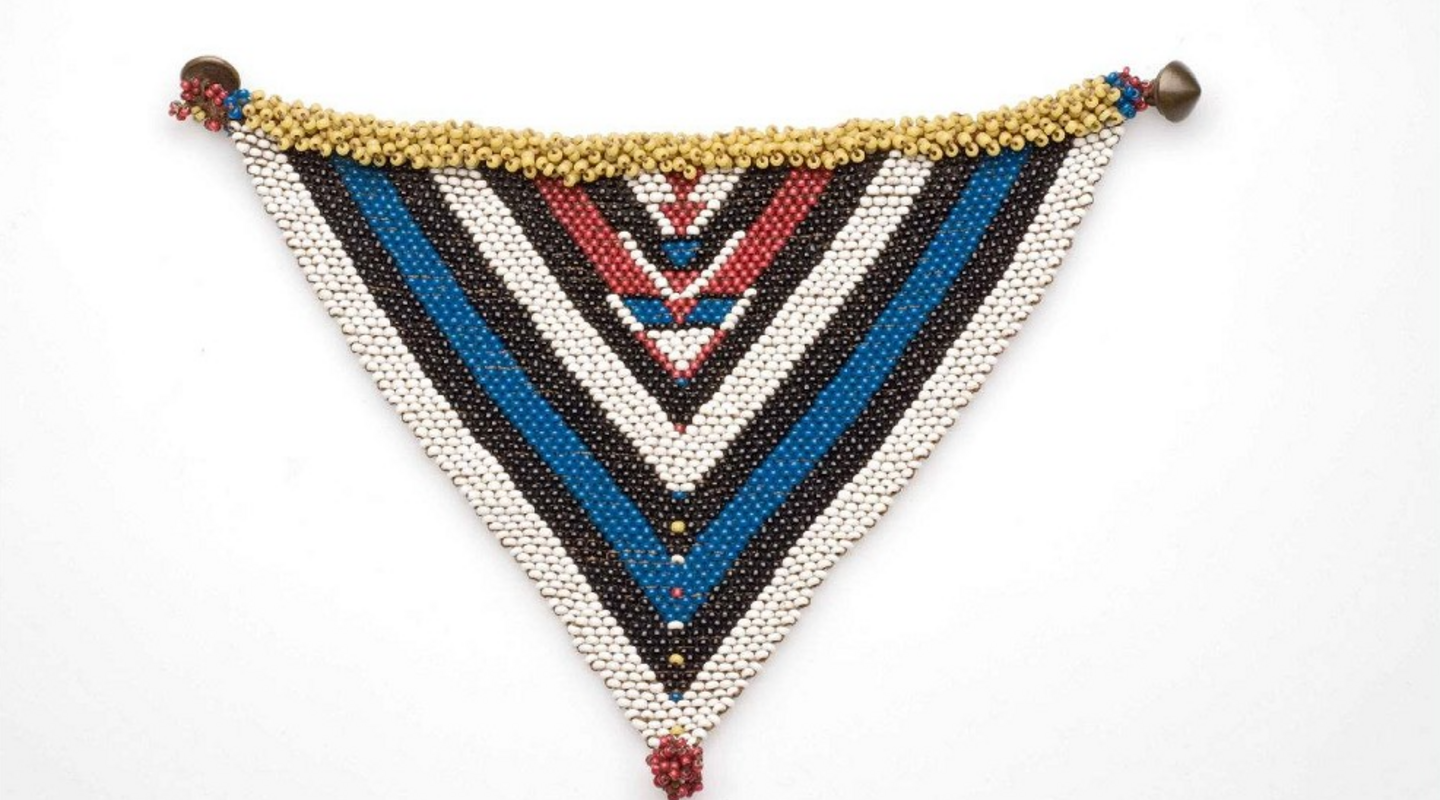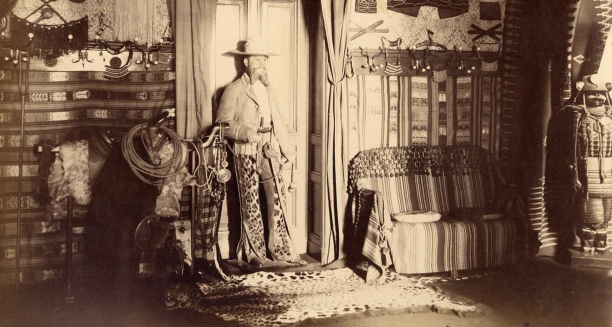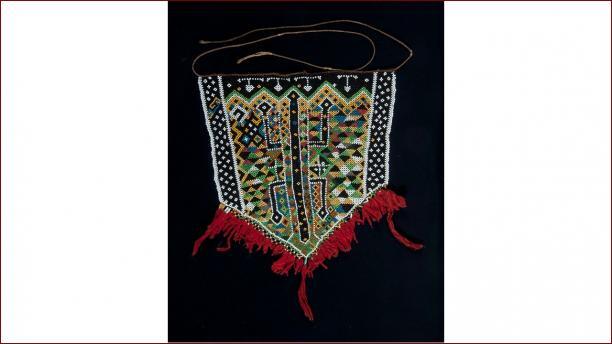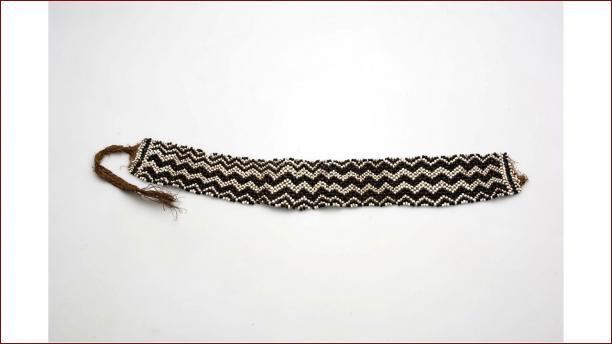Beadworks and Bodies – South African Waistbands in the Collection of Anthropologist Wilhelm Joest
Artikel

The fact that Joest ordered the statue himself and placed it so prominently in his home gives a good impression of his character – he was egocentric, ambitious, and concerned, above all, with appearances. What might be overlooked, however, are the objects arranged around the statue.

Hanging to the left and right are a series of beaded waistbands from the coastal regions of Southeast Africa. Today, these items of women’s beadwork are kept in the Rautenstrauch-Joest-Museum, Cologne, where their significance is ethnographic, pointing towards the cultural histories of their makers. Their former display next to the statue of their collector, however, challenges this straightforward synecdochical relationship and prompts the question of why a White man like Joest would have collected these immensely personal pieces of Black women’s clothing.

The beaded waistbands
To answer this question, it is important to first gain a better understanding of what these beaded waistbands would have meant to their former owners. Although beaded items are often thought of today as “traditional” African clothing, they are actually a modern invention. Glass beads were first introduced to Southern Africa by European traders, replacing earlier designs that used seeds and other natural materials. The techniques for threading and sewing them spread widely during the nineteenth century, leading to an explosion of new designs to signal personal and social identities. Historian Anitra Nettleton has shown how these items became a driving force behind a confident Black South African modernity, and she also points out the irony that for European collectors like Joest, these beadworks came to stand for their racist idea of a timeless African essence. Where they should have seen a dynamic cultural and aesthetic response to the encroaching presence of European colonialism, they could only see nudity, tribalism, and tradition.

Sexualisation of ethnographic objects
European ideas about beadwork, however, were not limited to racist notions of peoples without history. For Joest and his White male compatriots, these garments also carried decidedly sexual connotations. For example, in his travelogue Um Afrika, Joest writes that “the [Zulu] girls are only pretty when they walk about […] dressed in the tiny beaded belt (see Fig. 9); on the streets of Durban they cover their upper bodies and then acquire something repulsive, almost animal-like.” Although Zulu women would have been considered fully dressed in their waistbands, Joest imagines the “tiny beaded belt” as an item of erotic clothing. Probably as a result of these voyeuristic gazes, Zulu women had begun to cover themselves when in the company of White men, and Joest is so enraged by this restriction that he immediately resorts to racist language, denying the women their humanity. Unable (for the most part) to enforce his visual access, Joest instead acquired the object that had come to stand in for their sexualised and racialised bodies – the beaded waistbands. Not only did he collect them, but he made sure to link to a photograph in the sexualising text, demonstrating his possession and ethnographic mastery of these eroticised clothes. Finally, he displayed them like trophies in his apartment, for his male visitors to see and presumably touch – after all, they were conveniently placed close to the coat hooks.

What are the implications of these collection histories? First, it is important to note that Joest was not alone in his sexualisation of ethnographic objects. The White male gaze on the bodies and dress of women of colour was so commonplace in colonial anthropology that Peter Sigal, Zeb Tortorici, and Neil Whitehead have developed the concept of “ethnopornography” to describe this interplay of racialisation and sexualisation. Second, in today’s museums, this history is often ignored or actively hidden, and (beaded) clothing is displayed as an innocent marker of cultural identity. What is needed, then, is a new curatorial language that openly addresses the intrusive behaviour of collectors and the ongoing power dynamics inherent in the display of their collections. Like Joest, contemporary visitors may look at these waistbands with a desire for the racialised and sexualised bodies of Black women, and this continuity must be addressed and disrupted. Finally, it is important not to reduce the waistbands to their violent collecting history – before they were acquired, they embodied pride and identity, and as such, they can also become material for empowering counter-histories today.
Sources:
- Joest, Wilhelm. Um Afrika. Cologne: M. Dumont-Schauberg, 1885. Nettleton, Anitra. “Scars, Beads, Bodies: Pointure and Punctum in Nineteenth-Century ‘Zulu’ Beadwork and Its Photographic Imaging.” Image & Text 23 (2014): 161–85.
- Nettleton, Anitra. “Women, Beadwork and Bodies: The Making and Marking of Migrant Liminality in South Africa, 1850–1950.” African Studies 73, no. 3 (2014): 341–64.
- Sigal, Pete, Zeb Tortorici, and Neil L. Whitehead, eds. Ethnopornography. Sexuality, Colonialism, and Archival Knowledge. Durham & London: Duke University Press, 2020.
More on Joest:
- Deußen, Carl, and Anne Haeming, eds. Aus Indien Nach Santa Cruz Durch Die Ethnologie. Fragmente Des Forschungsreisenden Wilhelm Joest. Berlin: Matthes & Seitz, 2023.
- Deußen, Carl. “An Obscure Forschungsreisender? Wilhelm Joest and the Shaping of Ethnology in Late 19th Century Germany.” In BEROSE International Encyclopaedia of the Histories of Anthropology, 2022.
- Deußen, Carl. “Collecting Masculinities: Wilhelm Joest and the Masculinity of the Other.” In The Gender of Ethnographic Collecting, edited by Carl Deußen and Mary Mbewe, 34–40. Cologne: boasblogs, 2022.
- Haeming, Anne. Der Gesammelte Joest. Biografie Eines Ethnologen. Berlin: Matthes & Seitz, 2023.

Aanvullingen